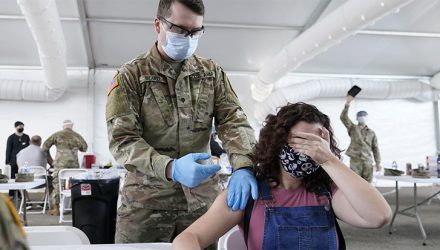The narrative is nice to imagine: The US economy will grow fast in 2021 as we beat the coronavirus and everyone shops freely, travels widely, and hugs random strangers.
There’s more. Trillions in government and Federal Reserve support will finance a consumer spending spree, keep the housing market strong, and bolster Wall Street’s bull market.
For all those to happen, we must achieve the precondition that will allow them: defeat the coronavirus. How’s that going?
By the numbers, the US looks much better than a few months ago. But we’ve seen how this goes. The virus spreads in waves that recede and then return, often stronger.
Vaccinations are supposed to break this cycle. And maybe they will. Unfortunately, that looks less likely as vaccine demand shows signs of peaking.
This may be a problem.

Source: Wikimedia Commons
New Dynamic
According to CDC data, about 131.2 million had received at least one dose of a COVID-19 vaccine in the United States as of April 18.
That’s great news. Most of the older people and others whom the virus strikes most severely are much safer now. But getting the vaccine to everyone else is proving to be a bigger challenge. Some states even have surplus doses.
As a result, about 200 million Americans haven’t received even one vaccine dose. They are still vulnerable, and can continue spreading the virus.
Survey data says something like 10–15% of US adults don’t want a vaccine at all. Another 10–15% are willing, but in “wait and see” mode. That’s potentially almost 80 million people who won’t be vaccinated this year, even if it’s available to them.
And we haven’t even started vaccinating children under age 16. They can carry the virus, even if it doesn’t make them sick as often. The FDA may approve a vaccine for children soon, but it will take time to deliver that many doses.
This creates an interesting new dynamic for the economy.
- Vaccinated people can resume more normal spending patterns, mostly (though not perfectly) safe from COVID-19.
- Unvaccinated people are still at high risk of infection. But their economic activity may not change much, since many have been circulating normally all along.
This seems to point toward recovery. But there are complications.
We don’t know how soon vaccinated people will return to normal life. Yes, they’re a lot safer now, but the fact that they went to the trouble of getting vaccinated says they are cautious. Some may remain so. And their habits may have changed in the last year.
As for the unvaccinated group, some probably had COVID-19 before, maybe unaware of it. They should have some degree of immunity.
But that will leave a large group of non-vaccinated, non-previously infected Americans. They have no immunity at all… and society has dropped many of the measures that had been protecting them, like masks and capacity limits.
It seems likely the virus will find most of that group. Experience says some percentage will get sick. A smaller percentage will die.
It might be more than we think, too.
CDC says around 81% of Americans age 65+ are vaccinated. That leaves roughly 11 million unvaccinated older Americans. Little will stop the virus from reaching them, and they have the highest fatality rates.
Selective Pandemic
After more than a year of caution, most Americans want normalcy. They are in no mood to take more lockdowns or mask mandates, even if governors order them, which is doubtful. But the vaccine-reluctant population is large enough to prevent herd immunity.
That means the next stage will be a selective pandemic. Some will be safe, others not. How will that affect consumer spending?
The optimistic view: Vaccinated people will get back to normal and the unvaccinated people will keep doing as they have been. Some will get sick, but the hospitals can handle them. Economic recovery will proceed as the virus fades away.
The pessimistic view: While vaccinated people may get out and spend more freely, it will be nothing like their pre-2020 activity because they fear variants and vaccine failure. Meanwhile the unvaccinated will gradually develop herd immunity the hard way.
We’ll see what happens. The problem is that Wall Street, and many small business owners, are anticipating not just a normal summer, but a blockbuster national boom. Some are hiring people, building capacity, and purchasing inventory as if the traditional holiday spending spree will happen in July.
It could happen. Vaccination progress may be peaking, but it won’t stop. Schools, colleges, and employers may compel some otherwise reluctant people to get it. Maybe, combined with previous infection, vaccines will end most of the fear, and the economy will race forward.
Far more likely, in my view, is a kind of uneven half-recovery, half-recession. It will be better than 2020 but more of a whimper than a boom.
And keep in mind, the US economy depends on the rest of the world’s economy, and most of the world hasn’t even started vaccinating.
Can the US sustain a historic boom while our primary trading partners stay in pandemic paralysis? I don’t see how. That would mean the boom, if there is one, won’t last long.
It will come eventually. But probably not this year.
Originally published by Mauldin Economics, 4/20/21








